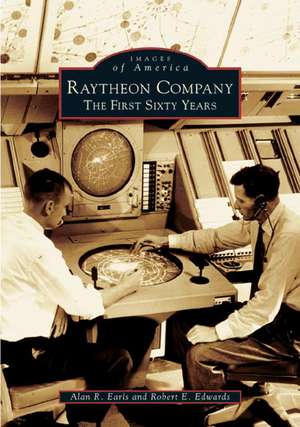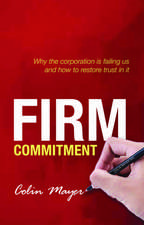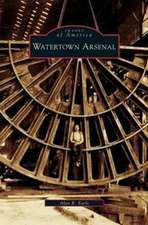Raytheon Company: The First Sixty Years: Images of America (Arcadia Publishing)
Autor Alan R. Earls, Robert E. Edwardsen Limba Engleză Paperback – 30 apr 2005
Cambridge-based company quickly moved to the forefront of innovation in the electronics industry. During World War II, thousands of Raytheon workers contributed to the war effort, supplying eighty percent of the magnetron tubes (vital components for U.S. and British radars), developing miniature tubes for the crucial proximity fuse in antiaircraft shells, and providing entire radar systems. Although government contracts slowed after World War II, Raytheon continued to develop military components, including leading-edge radars and missiles for America's defenses in the Cold War, but it also began to offer a host of civilian products: the famous RadaRange (the world's first microwave oven), televisions, marine radars, transistors, miniature hearing aids, and medical equipment.
| Toate formatele și edițiile | Preț | Express |
|---|---|---|
| Paperback (1) | 132.13 lei 3-5 săpt. | |
| Arcadia Publishing (SC) – 30 apr 2005 | 132.13 lei 3-5 săpt. | |
| Hardback (1) | 181.89 lei 6-8 săpt. | |
| – | 181.89 lei 6-8 săpt. |
Din seria Images of America (Arcadia Publishing)
-
 Preț: 133.17 lei
Preț: 133.17 lei -
 Preț: 133.00 lei
Preț: 133.00 lei -
 Preț: 131.94 lei
Preț: 131.94 lei -
 Preț: 133.00 lei
Preț: 133.00 lei -
 Preț: 133.00 lei
Preț: 133.00 lei -
 Preț: 127.20 lei
Preț: 127.20 lei -
 Preț: 127.39 lei
Preț: 127.39 lei -
 Preț: 132.35 lei
Preț: 132.35 lei -
 Preț: 173.20 lei
Preț: 173.20 lei -
 Preț: 117.50 lei
Preț: 117.50 lei -
 Preț: 132.54 lei
Preț: 132.54 lei -
 Preț: 118.13 lei
Preț: 118.13 lei -
 Preț: 133.17 lei
Preț: 133.17 lei -
 Preț: 131.94 lei
Preț: 131.94 lei -
 Preț: 128.26 lei
Preț: 128.26 lei -
 Preț: 133.00 lei
Preț: 133.00 lei -
 Preț: 133.17 lei
Preț: 133.17 lei -
 Preț: 133.00 lei
Preț: 133.00 lei -
 Preț: 131.94 lei
Preț: 131.94 lei -
 Preț: 133.41 lei
Preț: 133.41 lei -
 Preț: 127.20 lei
Preț: 127.20 lei -
 Preț: 131.94 lei
Preț: 131.94 lei -
 Preț: 120.40 lei
Preț: 120.40 lei -
 Preț: 131.72 lei
Preț: 131.72 lei -
 Preț: 127.20 lei
Preț: 127.20 lei -
 Preț: 131.94 lei
Preț: 131.94 lei -
 Preț: 132.76 lei
Preț: 132.76 lei -
 Preț: 131.94 lei
Preț: 131.94 lei -
 Preț: 136.28 lei
Preț: 136.28 lei -
 Preț: 127.39 lei
Preț: 127.39 lei -
 Preț: 133.17 lei
Preț: 133.17 lei -
 Preț: 133.00 lei
Preț: 133.00 lei -
 Preț: 133.41 lei
Preț: 133.41 lei -
 Preț: 117.72 lei
Preț: 117.72 lei -
 Preț: 133.17 lei
Preț: 133.17 lei -
 Preț: 117.72 lei
Preț: 117.72 lei -
 Preț: 133.00 lei
Preț: 133.00 lei -
 Preț: 128.26 lei
Preț: 128.26 lei -
 Preț: 132.13 lei
Preț: 132.13 lei -
 Preț: 131.94 lei
Preț: 131.94 lei -
 Preț: 131.94 lei
Preț: 131.94 lei -
 Preț: 133.41 lei
Preț: 133.41 lei -
 Preț: 133.41 lei
Preț: 133.41 lei -
 Preț: 131.94 lei
Preț: 131.94 lei -
 Preț: 118.31 lei
Preț: 118.31 lei -
 Preț: 127.61 lei
Preț: 127.61 lei -
 Preț: 131.94 lei
Preț: 131.94 lei -
 Preț: 131.94 lei
Preț: 131.94 lei -
 Preț: 133.41 lei
Preț: 133.41 lei
Preț: 132.13 lei
Nou
Puncte Express: 198
Preț estimativ în valută:
25.29€ • 27.48$ • 21.26£
25.29€ • 27.48$ • 21.26£
Carte disponibilă
Livrare economică 31 martie-14 aprilie
Preluare comenzi: 021 569.72.76
Specificații
ISBN-13: 9780738537474
ISBN-10: 0738537470
Pagini: 128
Dimensiuni: 167 x 237 x 9 mm
Greutate: 0.3 kg
Editura: Arcadia Publishing (SC)
Seria Images of America (Arcadia Publishing)
ISBN-10: 0738537470
Pagini: 128
Dimensiuni: 167 x 237 x 9 mm
Greutate: 0.3 kg
Editura: Arcadia Publishing (SC)
Seria Images of America (Arcadia Publishing)
Descriere
Raytheonas history is one of the great American success stories. Launched in 1922, the
Cambridge-based company quickly moved to the forefront of innovation in the electronics industry. During World War II, thousands of Raytheon workers contributed to the war effort, supplying eighty percent of the magnetron tubes (vital components for U.S. and British radars), developing miniature tubes for the crucial proximity fuse in antiaircraft shells, and providing entire radar systems. Although government contracts slowed after World War II, Raytheon continued to develop military components, including leading-edge radars and missiles for Americaas defenses in the Cold War, but it also began to offer a host of civilian products: the famous RadaRange (the worldas first microwave oven), televisions, marine radars, transistors, miniature hearing aids, and medical equipment.
Cambridge-based company quickly moved to the forefront of innovation in the electronics industry. During World War II, thousands of Raytheon workers contributed to the war effort, supplying eighty percent of the magnetron tubes (vital components for U.S. and British radars), developing miniature tubes for the crucial proximity fuse in antiaircraft shells, and providing entire radar systems. Although government contracts slowed after World War II, Raytheon continued to develop military components, including leading-edge radars and missiles for Americaas defenses in the Cold War, but it also began to offer a host of civilian products: the famous RadaRange (the worldas first microwave oven), televisions, marine radars, transistors, miniature hearing aids, and medical equipment.
Recenzii
Publication: Wicked Local
Article Title: Exhibit at Watertown Free Public Library chronicles womenas work in time of war
Author: Alan Earls
Date: 11/5/2008
In times past, but for a few prominent exceptions, such as Molly Pitcher in the American Revolution, women did not participate in military combat. Instead, they often took over roles on the ahome fronta traditionally reserved for men.
The role of women in support of national war efforts is the focus of an exhibit throughout the November at the T. Ross Kelly Family Gallery of the Watertown Free Library. Titled, aYes They Can!, a the exhibit of historic images showcases the lives and times of the Women of Watertown Arsenal, and other local employers, through a series of photographs selected by Alan R. Earls, from his Arcadia Publishing photo-history books, aWatertown Arsenal and Raytheon: the First 60 Years.a
aAlthough the photographers are anonymous, many of the images are reminiscent of those crafted by famed photographer Lewis W. Hines, a said Earls. Those photos capture the hard work and occasional triumphs of daily life in an industrial setting traditionally dominated by men and primarily span the period of World War I and World War II.
Although women were employed by the Arsenal as far back as the American Civil War a they represented more than 10 percent of the 800 employees at the time, according to historical records a and many more worked during World War I, it was in the Second World War, the age of Rosie the Riveter, that their numbers and influence really grew a with total employment reaching into the thousands.
And, in a nod to the future, said Earls, aThe photos from the Second WorldWar show a more confident and diverse workforce, with women and men of all races working together in many roles.a
Nationally, according to the Rosie the Riveter National Historical Site in Richmond, Calif., some 6 million women worked in defense industries and support services during World War II, including shipyards, steel mills, foundries, lumber mills, warehouses, offices, hospitals and daycare centers.
The Watertown Arsenal was operational from 1816 to 1967, initially serving primarily as a regional storage facility for military supplies. By the time of the Civil War, however, the arsenal had begun its transformation into a major facility for the design, development and manufacture of military products, particularly artillery.
Although the Arsenal faded from view after its 1967 closure, it didnat disappear. Army research activities occupied a section of the property until the late 1980s, for example, at the smaller research organizations such as the Army Materials and Mechanics Research Center. Many of the buildings associated with the Arsenal have gone on to serve new and important functions as the Arsenal Mall, offices and research spaces.
The women and the Arsenal may be gone, noted Earls, paraphrasing an inscription at the Rosie the Riveter historical site, aHowever, we should remember that, without women, there might have been no victory in 1945.a
The exhibit area is on the second floor of the library, 123 Main St., and admission is free. The T. Ross Kelly Family Gallery is open during normal library hours.
Article Title: Exhibit at Watertown Free Public Library chronicles womenas work in time of war
Author: Alan Earls
Date: 11/5/2008
In times past, but for a few prominent exceptions, such as Molly Pitcher in the American Revolution, women did not participate in military combat. Instead, they often took over roles on the ahome fronta traditionally reserved for men.
The role of women in support of national war efforts is the focus of an exhibit throughout the November at the T. Ross Kelly Family Gallery of the Watertown Free Library. Titled, aYes They Can!, a the exhibit of historic images showcases the lives and times of the Women of Watertown Arsenal, and other local employers, through a series of photographs selected by Alan R. Earls, from his Arcadia Publishing photo-history books, aWatertown Arsenal and Raytheon: the First 60 Years.a
aAlthough the photographers are anonymous, many of the images are reminiscent of those crafted by famed photographer Lewis W. Hines, a said Earls. Those photos capture the hard work and occasional triumphs of daily life in an industrial setting traditionally dominated by men and primarily span the period of World War I and World War II.
Although women were employed by the Arsenal as far back as the American Civil War a they represented more than 10 percent of the 800 employees at the time, according to historical records a and many more worked during World War I, it was in the Second World War, the age of Rosie the Riveter, that their numbers and influence really grew a with total employment reaching into the thousands.
And, in a nod to the future, said Earls, aThe photos from the Second WorldWar show a more confident and diverse workforce, with women and men of all races working together in many roles.a
Nationally, according to the Rosie the Riveter National Historical Site in Richmond, Calif., some 6 million women worked in defense industries and support services during World War II, including shipyards, steel mills, foundries, lumber mills, warehouses, offices, hospitals and daycare centers.
The Watertown Arsenal was operational from 1816 to 1967, initially serving primarily as a regional storage facility for military supplies. By the time of the Civil War, however, the arsenal had begun its transformation into a major facility for the design, development and manufacture of military products, particularly artillery.
Although the Arsenal faded from view after its 1967 closure, it didnat disappear. Army research activities occupied a section of the property until the late 1980s, for example, at the smaller research organizations such as the Army Materials and Mechanics Research Center. Many of the buildings associated with the Arsenal have gone on to serve new and important functions as the Arsenal Mall, offices and research spaces.
The women and the Arsenal may be gone, noted Earls, paraphrasing an inscription at the Rosie the Riveter historical site, aHowever, we should remember that, without women, there might have been no victory in 1945.a
The exhibit area is on the second floor of the library, 123 Main St., and admission is free. The T. Ross Kelly Family Gallery is open during normal library hours.
Notă biografică
Alan R. Earls, a technology and business writer, has covered high-technology stories since the early 1980s. Robert E. Edwards, a forty-three-year Raytheon veteran, was an engineering manager and is currently a volunteer at the Raytheon Archives.












